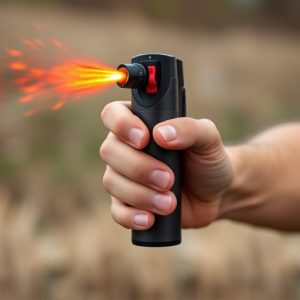Capsaicin Protection: Tactical Pepper Spray Canisters & Safety
Capsaicin, the active ingredient in chili peppers, is a powerful non-lethal self-defense tool. Tacti…….
Capsaicin, the active ingredient in chili peppers, is a powerful non-lethal self-defense tool. Tactical Reloading Pepper Spray Canisters utilize this compound for effective protection during tactical operations, targeting respiratory and sensory systems. Crafted with durable materials and advanced features, these canisters enable precise deployment for law enforcement, security personnel, and individuals. However, safe handling is crucial to prevent accidents and legal issues; informed usage involves training, understanding local regulations, and following best practices.
“Discover the power of capsaicin in personal protection with our in-depth look at tactical reloading pepper spray canisters. This article explores the science behind capsaicin, its effectiveness as a non-lethal self-defense tool, and the advanced design features of modern pepper spray canisters. We’ll delve into their applications for law enforcement and civilians alike, while also addressing safety considerations and legal implications. Enhance your knowledge about these innovative tactical tools, specifically focusing on Tactical Reloading Pepper Spray Canisters.”
- Understanding Capsaicin and Its Effectiveness in Personal Protection
- Tactical Reloading Pepper Spray Canisters: Design, Features, and Applications
- Safety Considerations and Legal Implications of Using Capsaicin-Based Devices
Understanding Capsaicin and Its Effectiveness in Personal Protection
Capsaicin, the active ingredient in chili peppers, has emerged as a powerful tool in personal protection devices. This natural compound is known for its ability to cause a burning sensation and temporarily disable an attacker, giving users precious time to escape or defend themselves. When incorporated into tactical pepper spray canisters, capsaicin offers a non-lethal yet highly effective solution for self-defense.
The effectiveness of capsaicin lies in its unique mode of action. It binds to specific receptors in the nose and eyes, leading to intense irritation and pain. This reaction is rapid and can disable an assailant for several minutes, enough time for a person to remove themselves from danger. Unlike traditional pepper spray, which relies on irritants that cause temporary blindness, capsaicin’s heat-sensitive properties ensure it targets the respiratory system and sensory organs directly involved in aggression, making it a game-changer in personal protection strategies, especially for tactical reloading scenarios.
Tactical Reloading Pepper Spray Canisters: Design, Features, and Applications
Tactical Reloading Pepper Spray Canisters are designed with precision and effectiveness in mind, catering to law enforcement officers, security personnel, and individuals seeking advanced personal protection. These canisters boast a robust build, often crafted from durable materials like metal or high-strength plastics, ensuring they withstand intense use during tactical operations. The design incorporates features such as adjustable wind shields, quick-release mechanisms, and ergonomic grips for easy deployment in split seconds.
In terms of applications, these pepper spray canisters are instrumental in neutralizing threats in various scenarios. Their strategic design allows users to direct the spray accurately, providing a safe distance from the target while delivering a powerful irritant. This versatility makes them indispensable tools for self-defense, anti-riot control, and search and rescue operations, where swift and effective deterrence is paramount.
Safety Considerations and Legal Implications of Using Capsaicin-Based Devices
When considering a capsicum-based personal protection device, such as tactical reloading pepper spray canisters, it’s imperative to weigh safety considerations. These devices contain capsaicin, the compound responsible for the heat and irritation associated with chili peppers. While effective in deterring potential threats, improper use or exposure can lead to adverse effects. Users must be trained on safe handling practices, including understanding range limitations, proper application techniques, and post-use care to minimize risks like accidental injuries, respiratory issues, or long-term sensitivity to capsaicin.
Legally, the use of capsicum-based devices is subject to varying regulations across jurisdictions. Some regions permit their possession for self-defense purposes, while others may restrict their sale and use. It’s crucial to familiarize yourself with local laws and obtain any required permits or licenses before purchasing or carrying a tactical reloading pepper spray canister. Non-compliance can result in legal consequences, including fines or imprisonment, emphasizing the need for informed usage and understanding of one’s rights and responsibilities.
In conclusion, tactical reloading pepper spray canisters equipped with capsaicin-based technology offer a powerful personal protection solution. Their design and unique features make them a valuable tool for self-defense in various situations. While considering safety and legal aspects is crucial, the effectiveness of capsaicin as a non-lethal deterrent highlights its potential to empower individuals. By understanding these devices’ capabilities and adhering to responsible use guidelines, users can leverage tactical reloading pepper spray canisters for enhanced personal security.

